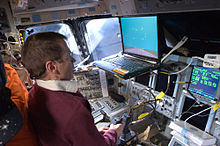Gregory C. Johnson
This poorly sourced must be removed immediately from the article and its talk page, especially if potentially libelous. )Find sources: "Gregory C. Johnson" – news · newspapers · books · scholar · JSTOR (March 2010) |
Gregory Johnson | |
|---|---|
NASA astronaut | |
| Rank | Captain, USNR |
Time in space | 12d 21h 38m |
| Selection | NASA Group 17 (1998) |
| Missions | STS-125 |
Mission insignia | |
Gregory Carl "Ray J" Johnson (born July 30, 1954), (
Personal data
Johnson was born on July 30, 1954, in
Johnson enjoys
Johnson received his commission as an
In 1980, then
In 1984, Johnson reported to the
Johnson resigned his Regular Navy commission in 1990 and transferred back to the Naval Reserve while accepting a concurrent civil service position with the
He has logged over 10,800 flight hours in 50 aircraft types and has accumulated over 500 carrier landings. He retired from the U.S. Navy with over 30 years of service effective October 1, 2007.[1]
NASA career
In April 1990, Johnson was accepted as an aerospace engineer and research pilot at the NASA JSC Aircraft Operations Division,
Selected by NASA as an astronaut candidate in June 1998, he reported for training in August 1998. Johnson was the class leader for the seventeenth group of astronauts, with 31 U.S. and international members. Johnson was initially assigned as an Astronaut Support Personnel (ASP) responsible for configuring the Orbiter switches prior to launch and strapping astronauts in their seats for launch. More recently he served as the
Johnson graduated with fellow astronaut
Spaceflight experience
STS-125

Johnson was the pilot on STS-125, the final Space Shuttle mission to the Hubble Space Telescope. It lasted from May 11–24, 2009, traveling 5,276,000 miles in 197 Earth orbits. Atlantis carried two new instruments to the telescope, the Cosmic Origins Spectrograph and the Wide Field Camera 3. The mission also replaced a Fine Guidance Sensor, six gyroscopes, and two battery unit modules to allow the telescope to continue to function at least through 2014. The crew also installed new thermal blanket insulating panels to provide improved thermal protection, and a soft-capture mechanism that would aid in the safe de-orbiting of the telescope by an unmanned spacecraft at the end of its operational lifespan. The mission also carried an IMAX camera and the crew documented the progress of the mission for the movie Hubble.[2]
Organizations
- Association of Space Explorers
- Society of Experimental Test Pilots
- American Institute of Aeronautics and Astronautics
- Tau Beta Pi Honorary Engineering Society
- Naval Reserve Association
- Tailhook Association
Awards and honors
- NASA James A. Korkowski Excellence in Achievement Award
- VA-128 Attack Pilot of the Year
- Carrier Air Wing Fifteen (CVW-15) Top Ten Tailhook Pilot
- Carrier Air Wing Fourteen (CVW-14) Top Ten Tailhook Pilot
- Meritorious Service Medal (3)
- Navy and Marine Corps Commendation Medal(3)
- Navy and Marine Corps Achievement Medal
- Navy Expeditionary Medal
- National Defense Service Medal (2)
- Armed Forces Expeditionary Medal
- Humanitarian Service Medal
- War on Terrorism Service Medal
- Armed Forces Reserve Medal
- NASA Space Flight Medal
Johnson also received many other awards and decorations.[1]
References
![]() This article incorporates public domain material from websites or documents of the
This article incorporates public domain material from websites or documents of the
- ^ a b c d e "Johnson's official NASA biography" (PDF). NASA. February 2017. Retrieved April 2, 2021.
- ^ Pearlman, Robert Z. (May 19, 2009). "Hubble's Last Visit To Be Relived in 3-D". space.com. Retrieved January 25, 2023.
External links
- "Johnson's official NASA biography" (PDF). NASA. February 2017. Retrieved April 2, 2021.
- Astronautix biography of Gregory C. Johnson
- Spacefacts biography of Gregory C. Johnson
- Johnson at Spaceacts Archived September 4, 2019, at the Wayback Machine

